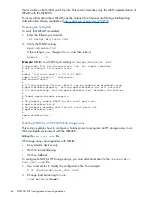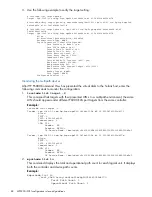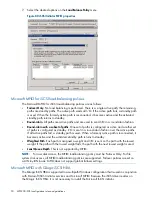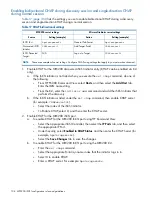
7.
Select the desired options on the
Load Balance Policy
menu.
Figure 80 iSCSI Initiator MPIO properties
Microsoft MPIO for iSCSI load-balancing policies
The Microsoft MPIO for iSCSI load-balancing policies are as follows:
•
Failover Only
. No load balancing is performed. There is a single active path; the remaining
paths are standby paths. The active path sends all I/O. If the active path fails, a standby path
is used. When the formerly active path is reconnected, it becomes active and the activated
standby path returns to standby.
•
Round-robin
. All paths are active paths and are used to send I/O in a round-robin fashion.
•
Round-robin with a subset of paths
. One set of paths is configured as active and another set
of paths is configured as standby. I/O is sent in a round-robin fashion over the active paths.
If all active paths fail, a standby path is used. When a formerly active path is reconnected, it
becomes active and the activated standby path returns to standby.
•
Weighted Path
. Each path is assigned a weight and I/O is sent on the path with the lowest
weight. If the path with the lowest weight fails, the path with the next lowest weight is used.
•
Least Queue Depth
. This is not supported by MPIO.
NOTE:
For raw disk access, the MPIO load-balancing policy must be Failover Only. For file
system disk access, all MPIO load-balancing policies are supported. Failover policies are set on
a LUN-by-LUN basis. MPIO does not support global failover settings.
Microsoft MPIO with QLogic iSCSI HBA
The QLogic iSCSI HBA is supported in a multipath Windows configuration that is used in conjunction
with Microsoft iSCSI initiator services and Microsoft MPIO. Because the iSCSI driver resides on
the QLogic iSCSI HBA, it is not necessary to install the Microsoft iSCSI initiator.
90
MPX200 iSCSI configuration rules and guidelines






























